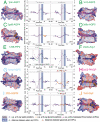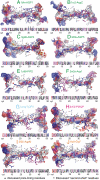Electrostatics of aquaporin and aquaglyceroporin channels correlates with their transport selectivity
- PMID: 20147624
- PMCID: PMC2819975
- DOI: 10.1073/pnas.0910632107
Electrostatics of aquaporin and aquaglyceroporin channels correlates with their transport selectivity
Abstract
Aquaporins are homotetrameric channel proteins, which allow the diffusion of water and small solutes across biological membranes. According to their transport function, aquaporins can be divided into "orthodox aquaporins", which allow the flux of water molecules only, and "aquaglyceroporins", which facilitate the diffusion of glycerol and other small solutes in addition to water. The contribution of individual residues in the pore to the selectivity of orthodox aquaporins and aquaglyceroporins is not yet fully understood. To gain insights into aquaporin selectivity, we focused on the sequence variation and electrostatics of their channels. The continuum Poisson-Boltzmann electrostatic potential along the channel was calculated and compared for ten three-dimensional-structures which are representatives of different aquaporin subfamilies, and a panel of functionally characterized mutants, for which high-accuracy three-dimensional-models could be derived. Interestingly, specific electrostatic profiles associated with the main selectivity to water or glycerol could be identified. In particular: (i) orthodox aquaporins showed a distinctive electrostatic potential maximum at the periplasmic side of the channel around the aromatic/Arg (ar/R) constriction site; (ii) aquaporin-0 (AQP0), a mammalian aquaporin with considerably low water permeability, had an additional deep minimum at the cytoplasmic side; (iii) aquaglyceroporins showed a rather flat potential all along the channel; and (iv) the bifunctional protozoan PfAQP had an unusual all negative profile. Evaluation of electrostatics of the mutants, along with a thorough sequence analysis of the aquaporin pore-lining residues, illuminated the contribution of specific residues to the electrostatics of the channels and possibly to their selectivity.
Conflict of interest statement
The authors declare no conflict of interest.
Figures



Similar articles
-
Molecular dynamics study of the archaeal aquaporin AqpM.BMC Genomics. 2011 Dec 22;12 Suppl 4(Suppl 4):S8. doi: 10.1186/1471-2164-12-S4-S8. Epub 2011 Dec 22. BMC Genomics. 2011. PMID: 22369250 Free PMC article.
-
Major intrinsic protein superfamily: channels with unique structural features and diverse selectivity filters.Methods Enzymol. 2015;557:485-520. doi: 10.1016/bs.mie.2014.12.006. Epub 2015 Mar 24. Methods Enzymol. 2015. PMID: 25950979
-
Structural determinants of the hydrogen peroxide permeability of aquaporins.FEBS J. 2014 Feb;281(3):647-56. doi: 10.1111/febs.12653. Epub 2013 Dec 13. FEBS J. 2014. PMID: 24286224
-
Cellular and molecular biology of the aquaporin water channels.Annu Rev Biochem. 1999;68:425-58. doi: 10.1146/annurev.biochem.68.1.425. Annu Rev Biochem. 1999. PMID: 10872456 Review.
-
On the definition, nomenclature and classification of water channel proteins (aquaporins and relatives).Mol Aspects Med. 2012 Oct-Dec;33(5-6):514-7. doi: 10.1016/j.mam.2012.04.003. Epub 2012 Apr 19. Mol Aspects Med. 2012. PMID: 22542572 Review.
Cited by
-
Aquaporins: More Than Functional Monomers in a Tetrameric Arrangement.Cells. 2018 Nov 11;7(11):209. doi: 10.3390/cells7110209. Cells. 2018. PMID: 30423856 Free PMC article. Review.
-
Multiscale Simulations of Biological Membranes: The Challenge To Understand Biological Phenomena in a Living Substance.Chem Rev. 2019 May 8;119(9):5607-5774. doi: 10.1021/acs.chemrev.8b00538. Epub 2019 Mar 12. Chem Rev. 2019. PMID: 30859819 Free PMC article.
-
Aquaporin-graphene interface: relevance to point-of-care device for renal cell carcinoma and desalination.Interface Focus. 2018 Jun 6;8(3):20170066. doi: 10.1098/rsfs.2017.0066. Epub 2018 Apr 20. Interface Focus. 2018. PMID: 29696094 Free PMC article. Review.
-
dbAQP-SNP: a database of missense single-nucleotide polymorphisms in human aquaporins.Database (Oxford). 2023 Mar 13;2023:baad012. doi: 10.1093/database/baad012. Database (Oxford). 2023. PMID: 36913438 Free PMC article.
-
Structure, Dynamics, and Substrate Specificity of the OprO Porin from Pseudomonas aeruginosa.Biophys J. 2015 Oct 6;109(7):1429-38. doi: 10.1016/j.bpj.2015.07.035. Biophys J. 2015. PMID: 26445443 Free PMC article.
References
Publication types
MeSH terms
Substances
Grants and funding
LinkOut - more resources
Full Text Sources
Molecular Biology Databases
Research Materials

